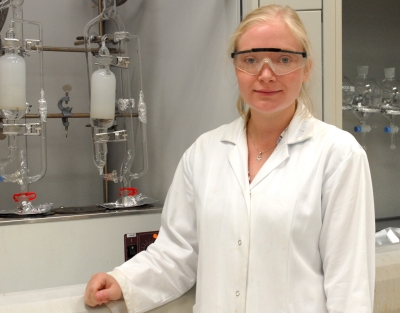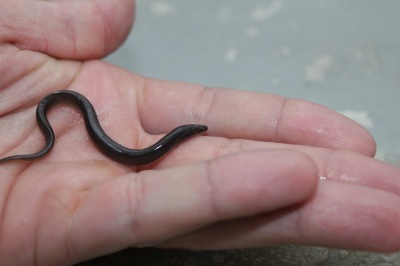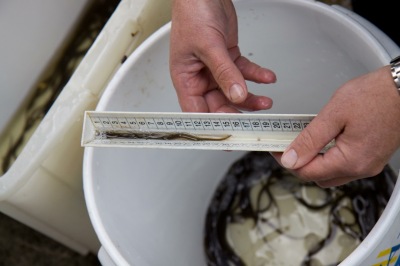Geesthacht coastal research scientist finds evidence of new type of flame retardant in eels
Within the scope of her doctoral thesis, Roxana Sühring from the Institute of Coastal Research at the Helmholtz-Zentrum Geesthacht is examining how flame retardants accumulate in the fatty tissue of eels. The special focus hereby is on emerging flame retardants being used to replace chemicals which have already been banned. Ms Sühring found evidence of both the banned and new types of flame retardants in all the eel tissue samples which she examined – in some cases in high concentrations when compared to the rest of Europe. The results have been published in the scientific journal “Chemosphere”.
Decline in eel stocks

Photo: HZG/ Heidrun Hillen
Stock levels of the European eel have declined significantly over the last 30 years. Marko Freese from the Thünen Institute of Fisheries Ecology (Thünen-Institut für Fischereiökologie) in Hamburg commented: “in addition to changes in natural habitat, overfishing and various other factors, pollutants are believed to be a possible reason for this strong decline in stocks”.
Scientists from various research facilities are working together, within the scope of the data collection programme “Data Collection Framework” of the European Commission, to determine which factors play a role in the decline of eel stocks and which measures are appropriate to ensure that stocks can recover.
This also includes investigations carried out within the “POPs in Eels Project” of the Department of Environmental Chemistry at the Institute of Coastal Research of the Helmholtz-Zentrum Geesthacht (HZG). Roxana Sühring, who is a doctoral student at the Helmholtz-Zentrum Geesthacht, explains: “I would like to find out which role previous and emerging types of flame retardant play in the decline of eel stocks”.
Deployment and Diffusion of flame retardants
Flame retardants are added to plastics and textiles in order to make them more flame resistant. Some of these chemicals pose a threat to human health and the ecology and are persistent in the environment. The manufacture and utilization of some flame retardants such as polybrominated diphenylethers (PBDEs) have been restricted or prohibited since 2004 under the “Stockholm Convention on Persistent Organic Pollutants (POPs)”.
However, flame retardants are currently being put onto the market which are chemically similar to these, but which have not yet been regulated. The utilization of flame retardants worldwide is estimated to be several hundred thousand tons per year.
Flame retardants in Eels

(Foto: Jan-Dag Pohlmann).
Ms Sühring has established that high concentrations of banned PBDEs are still present in adult eel stocks, in comparison with the young eels examined by her, and in comparison with the average concentrations in eels from other European countries. Alternative brominated flame retardants or chlorinated dechloranes are currently being used as substitutes.
Roxana Sühring was able to detect these substances at all stages of the eel life cycle. These substitutes are present in higher concentrations than PBDEs in young eels in particular. Working in cooperation with scientists from the Thünen Institute, the environmental chemist has analysed tissue samples from approx. 90 European eels, from the Elbe, the Rhine and the German/Danish River Vidå, at various stages in their life cycle.
Due to the fact that eels live in oceans and river estuary areas before they migrate upriver at an age of one to three years, the samples examined by Roxana Sühring not only revealed the concentration of chemicals in the tissue but also the location at which the substances were absorbed. The new types of flame retardant are absorbed both in river mouth areas by the younger eels and further upriver by adult eels.

(Foto: Jan-Dag Pohlmann).
The PBDEs, which are now banned, were predominantly found upriver – above all in samples from the industrial areas on the Rhine. It is of particular note that Ms Sühring was able to establish the presence of the chlorinated flame retardant Dec-602, which is neither produced in Europe nor imported to Europe. As a result of Ms Sühring’s research, investigations into dechlorane Dec-602 in European aquatic organisms have been carried out for the first time and its presence verified.
It is a known fact that halogenated organic compounds pose a risk for humans and the environment. Brominated flame retardants and chlorinated dechloranes also belong to this group of substances. However, according to Ms Sühring, there is not enough research data available in order to estimate the risks that these new types of flame retardants present and there are, therefore, no official limit values. Further investigations must be carried out in order to draw scientifically valid conclusions as to which role flame retardants play in the decline of eel stocks.
Further Information
Department "Environmental Chemistry" at the Institute of Coastal Research at the Helmholtz-Zentrums Geesthacht The Publication „Brominated flame retardants and dechloranes in eels from German Rivers“ in the Journal „Chemosphere“
